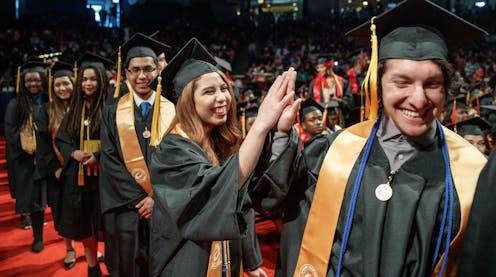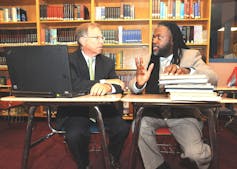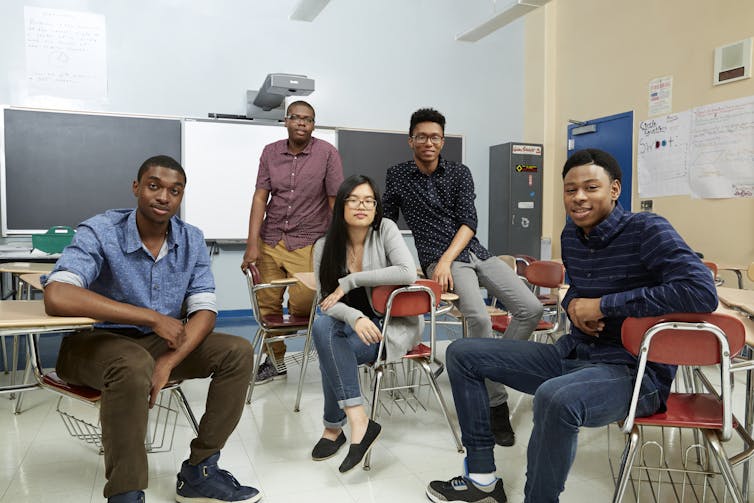P-TECH high school model connects students to college and careers
An innovative school model, known as P-TECH, that enables high school students to graduate with a two-year college degree and get jobs with partner corporations is showing encouraging results.

In his 2013 State of the Union address, President Barack Obama highlighted an innovative educational program called P-TECH – an acronym for Pathways in Technology Early College High School.
The first P-TECH school opened in Brooklyn, New York, in 2011. It was profiled in a 2014 cover story in Time magazine as “The School That Will Get You a Job.”
Obama stated that all students should have educational opportunities such as P-TECH. What makes the school unique is that students can earn an associate degree at no cost while still in high school. Students at the schools get the opportunity to compete for paid industry internships. They are also given mentors and a clear pathway from school to college to career with a commitment from business partners like IBM that they are first in line for available jobs.
Now, nearly a decade later, there are over 200 P-TECH schools throughout the United States and in 22 countries around the world. Collectively, the schools serve over 150,000 students.
My familiarity with P-TECH is not as one who merely read about the school or heard President Obama talk about it on TV. When I served as vice president of corporate affairs at IBM in 2010, I had the opportunity to design P-TECH and help launch and replicate it.

In my forthcoming book – co-authored by Tina Kelley, a former reporter with The New York Times – we will tell the P-TECH story and its ability to help reverse educational inequality over a half-century after the Brown v. Board of Education Supreme Court ruling that banned segregation in America’s public schools.
Positive findings
The academic success that students in the program have achieved was recently highlighted in a federally funded evaluation performed by MDRC, a nonprofit organization that conducts education and social policy research. Among other things, the MDRC report contains “encouraging early findings” about how P-TECH is working in terms of helping students move from high school to college and career.
In particular, the report found that the increased accumulation of career and technical education and other nonacademic credits is “evidence that these schools are providing students with greater levels of career-related exposure than students enrolled in other schools.” It also said the variety of career and technical education courses suggests that P-TECH schools are “providing different and potentially more modern career experiences.”
Students at the initial school in Brooklyn, now in its ninth year, have community college completion rates four times higher than the national average. But how are P-TECH schools faring when it comes to matters of racial equity and inclusion?
Open to all
The student population at the initial P-TECH school is 100% students of color and overwhelmingly low-income, with significant numbers of students performing below grade level upon entry. Unlike New York City’s other high-quality, high-performing schools, such as Stuyvesant High School and Bronx Science, P-TECH has no exam or admissions screen for entry.
Entrance screens in place in schools across New York City – and nationally – severely restrict the entry of students who are Black and Latino, reinforcing the fact that over a half-century since the Brown ruling, far too many U.S. school districts offer one set of opportunities to white students and another for students of color.

By way of example only 10 out of about 760 students admitted into Stuyvesant High School in 2020 are Black. At P-TECH in Brooklyn, anywhere from 82% to 87% of its students are Black. The Black male population is one of the highest of any school in New York City, and its achievement levels are also among the highest in the city.
Into the world of work
But the story of diversity at P-TECH is perhaps best told through the lens of its students.
Cletus Andoh grew up in Brooklyn and neither of his parents attended college. He filled out his standard high school application but was denied entry into all of his top 11 choices. Instead, he started at P-TECH in the fall of 2011. He quickly achieved college readiness, enrolling in college courses beginning after ninth grade. His academic success resulted in achieving a high school diploma and an associate of applied science, or AAS degree, in computer science in 2015 – two years ahead of schedule. He benefited from mentorship and paid internships at IBM. Cletus got a scholarship and admission to Syracuse University and completed his bachelor’s degree. He got a competitive job offer from IBM’s Hybrid Cloud Division, one of the most competitive business units at the company, where he remains to this day.
Oscar Tendilla is a DACA student who was performing quite poorly in middle school, often distracted by fear his undocumented parents would be deported. Given the opportunity of the melded high school and college experience that P-TECH offers, Oscar began to shine. Like Cletus he began taking college courses at the end of grade nine, and wound up completing his high school diploma and AAS degree in computer science in 3 ½ years. He, too, had mentoring and paid internships. His scholarship offer came from Cornell, where he is now a senior. Unlike Cletus, who envisions a career in technology, Oscar told me he envisions a career in education to provide students like him the support and opportunity he was given.
ShuDon Brown completed the P-TECH program early as well. With her diploma and AAS in computer information systems, she completed both her bachelor’s degree in business analytics from William Peace University in Raleigh, North Carolina, and a master’s degree in information science from North Carolina Agricultural and Technical State University while working at IBM in North Carolina. Currently she is balancing her IBM career while starting a doctoral program.
The stories don’t end there. Hundreds of others benefited from open admissions with no barrier to entering P-TECH.
Most who got their two-year degrees also got or are pursuing their bachelor’s degrees, and dozens are working at IBM. And this October Devon James, another P-TECH graduate who completed his bachelor’s degree at University at Albany SUNY, became the 37th student from P-TECH to be hired by IBM.
P-TECH schools across the U.S. are experiencing similar success. From one P-TECH school in Buffalo, New York, 15 graduates have been offered jobs at Tesla, according to information I was provided by Buffalo Public Schools.
[Deep knowledge, daily. Sign up for The Conversation’s newsletter.]
Opportunity in this country, I would argue, depends first and foremost on educational opportunity.
While educational opportunities for students of color are often limited by admissions screening into the highest-performing high schools, I would argue that the stories of P-TECH students demonstrate that given the right opportunities – coupled with the right supports via the integration of high school, college and career – all students can succeed if the opportunity and support are provided.
Stanley S Litow does not work for, consult, own shares in or receive funding from any company or organization that would benefit from this article, and has disclosed no relevant affiliations beyond their academic appointment.
Read These Next
West Coast levee failures show growing risks from America’s aging flood defenses
Levees protect more than 7 million buildings in the US today, yet they got a D-plus grade in 2025. A…
LA fires showed how much neighborliness matters for wildfire safety – schools can do much more to te
Managing fire risk is about more than regulations and rules. It’s also about caring for neighbors…
Has the Fed fixed the economy yet? And other burning economic questions for 2026
As 2026 begins, uncertainty is at the top of everyone’s mind.






